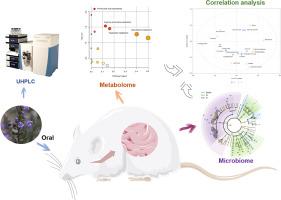Dracocephalum moldavica L. tea alleviates high-fat diet-induced hyperlipidemia in rats via gut microbiota and lipid metabolism
IF 7.2
Q1 FOOD SCIENCE & TECHNOLOGY
引用次数: 0
Abstract
Hyperlipidemia is a common metabolic disorder and a major risk factor for cardiovascular diseases. Dracocephalum moldavica L., a species of Dracocephalum in the family Labiatae, has a long history of medicinal use, often as tea (non-Camellia tea) to lower blood sugar and lipid levels. However, its exact mechanism of action remains unknown, hindering its therapeutic effectiveness. In this study, the lipid-regulating mechanism of the ethyl acetate extract of D. moldavica (EAD) was evaluated. The chemical constituents of EAD were preliminarily characterized using ultra-high performance liquid chromatography. A rat model of hyperlipidemia was induced by a high-fat diet and different doses of EAD were administered. Body weight, liver weight, and kidney weight were measured, along with biochemical indexes related to lipid metabolism. Intestinal content samples were analyzed using 16S rRNA sequencing technology to determine differences in intestinal bacterial composition. Differential metabolites were identified by serum metabolomics. The results showed that EAD reduced the weight of rats on a high-fat diet, along with liver weight and kidney weights, approaching levels similar to those in the normal group. Biochemical indexes related to lipid metabolism in the serum of rats on a high-fat diet were also improved. Furthermore, daily supplementation of EAD induced structural changes in the gut microbiota of rats, particularly by regulating the relative abundance of important microbes. Additionally, enrichment of metabolite metabolic pathways in plasma revealed the regulation of amino acid metabolism and primary bile acid synthesis after EAD administration. These results indicate that EAD alleviates hyperlipidemia in rats by regulating lipid metabolism and gut microbiota, providing insight into dyslipidemia regulation by D. moldavica.

龙头茶通过肠道菌群和脂质代谢减轻高脂饮食诱导的大鼠高脂血症
高脂血症是一种常见的代谢紊乱,是心血管疾病的主要危险因素。龙头草moldavica L.是唇形科龙头草的一种,具有悠久的药用历史,通常作为茶(非茶树茶)来降低血糖和血脂水平。然而,其确切的作用机制尚不清楚,阻碍了其治疗效果。本研究对龙葵乙酸乙酯提取物(EAD)的血脂调节机制进行了研究。采用超高效液相色谱法对EAD的化学成分进行了初步表征。采用高脂饮食诱导大鼠高脂血症模型,并给予不同剂量的EAD。测定体重、肝脏体重、肾脏体重及脂质代谢相关生化指标。采用16S rRNA测序技术分析肠道内容物样本,确定肠道细菌组成差异。血清代谢组学鉴定差异代谢物。结果显示,EAD降低了高脂肪饮食大鼠的体重,以及肝脏和肾脏的重量,接近正常组的水平。高脂饮食大鼠血清脂质代谢相关生化指标也有所改善。此外,每天补充EAD诱导了大鼠肠道微生物群的结构变化,特别是通过调节重要微生物的相对丰度。此外,血浆中代谢物代谢途径的富集揭示了EAD给药后氨基酸代谢和初级胆汁酸合成的调节。这些结果表明EAD通过调节脂质代谢和肠道微生物群来缓解大鼠高脂血症,为霉霉调节血脂异常提供了新的思路。
本文章由计算机程序翻译,如有差异,请以英文原文为准。
求助全文
约1分钟内获得全文
求助全文

 求助内容:
求助内容: 应助结果提醒方式:
应助结果提醒方式:


